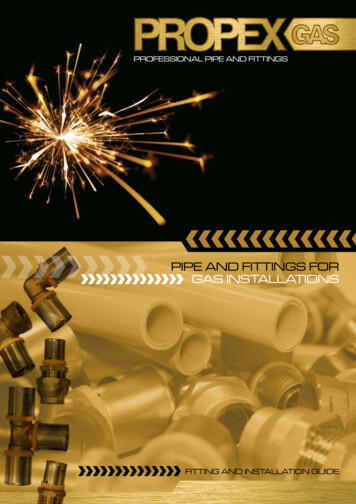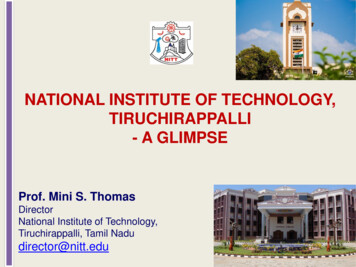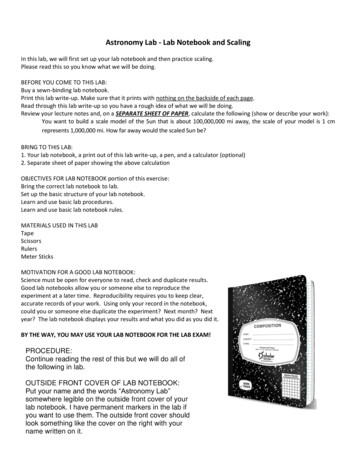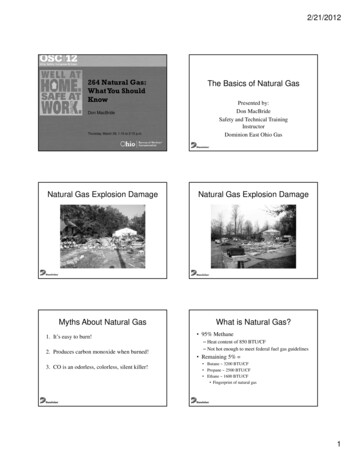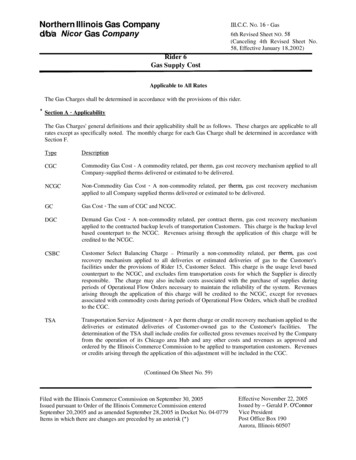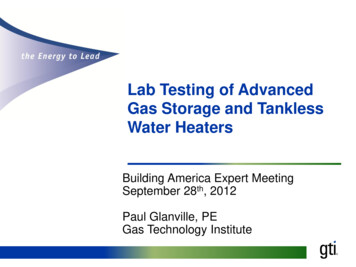
Transcription
Lab Testing of AdvancedGas Storage and TanklessWater HeatersBuilding America Expert MeetingSeptember 28th, 2012Paul Glanville, PEGas Technology Institute
Motivation for Testing Goal is to provide detailed understanding of generalfield performance and investigate operational issuesof interest for gas-fired residential water heaters. Lab tests performed by: Gas Technology Institute (GTI) Focus on short-term performance of Tankless WHs with simulateduse tests and a battery of short term tests. PG&E Applied Technology Services (ATS) Performed 24 Hour Simulated Use tests of Storage WHs, focusingon performance differentiation amongst higher EF SWHs, includingparasitic electricity consumption.NOTE: Neither PG&E ATS nor GTI are certified laboratories for the rating of residential water heaters, results reported are onlyrelevant in relative comparison to data from this project.CECTechnologyGas500-08-060InstitutePAC Meeting Presentation 4/17/122
Storage Water Heater Tests “15 Year Old” Water Heaters 2 recovered from field test sites for EFdegradation test 0.67 EF Energy Star Water Heaters (0.62 0.70 EF) Performance comparison includingelectric parasitic for atmospheric (ventdamper) vs. power vent vs. direct vent Different hot water draw pattern 24 testsand derated EFs EF for Non-EF Rated Condensing Water Heaters Generate non-certified EF rating for TE rated units Different hot water draw pattern 24 tests and derated EFsCECTechnologyGas500-08-060InstitutePAC Meeting Presentation 4/17/123
Storage Water Heater ResultsEfficiency ResultsDescriptionKey takeawaysDOE FirstHourRatingDOEStd est“15 Year Old” Water Heater63800.640.590.600.440.62 EF Atmos71700.620.600.600.480.67 EF Atmos/Vent Damper67700.670.660.660.570.67 EF Power Vent70890.670.640.640.530.67 EF Direct Vent73760.670.640.640.530.70 EF AtmosFan Boost70770.700.660.660.54Hybrid189130 [2] 90% [3] 0.680.680.56Condensing Storage1230.730.6214890% [3] 0.74[1] EF results for the DOE standard draw have been adjusted according to the DOE standard procedures foroperational offsets from the standard test conditions and the change in stored energy between the start and theend of the test. The GTI profile tests have only been adjusted for the change in stored energy.[2] These results are under review, the manufacturer was consulted and it was suggested that an unwantedblockage existed in the recirculation loop, the results were not representative of a properly working product.[3] Both the Hybrid (100,000 Btuh) and the Condensing (76,000 Btuh) are rated with burner inputs above75,000 Btuh, and thus are classified as commercial units and have a thermal efficiency rating.CECTechnologyGas500-08-060InstitutePAC Meeting Presentation 4/17/12 Efficiency is strong function of dailyhot water draw. DOE and GTI-Mid( 64 gal/day) have similar results. Suggesting validity of I/O MOT,including stored energyadjustment (w/ TC tree). Lower daily volume has consistentlylower efficiencies, greater portion ofenergy output lost as standbylosses.4
Storage Water Heater ResultsInput vs. OutputEfficiency vs. Daily VolumeCurves are derived from I/O lineswith a 77 F temperature rise I/O Chart (Left) shows linear relationship quantified on prior slide EFestimate vs. Daily draw (Right) trends are found with SWH field data and is typical for SWHs and TWHs alikeCECTechnologyGas500-08-060InstitutePAC Meeting Presentation 4/17/125
Storage Water Heater Results0.62EF AtmosphericAO Smith ProMax GVR-40Standby Heat LossDOE Energy Factor Test15 Year Old Water Heater0.62 EF Atmos0.67 EF Atmos/VentDamper0.67 EF Power Vent0.67 EF Direct Vent0.70 EF Atmos/Fan BoostHybridCondensing StorageNon-firingEnergy .4Water Flow (GPM)Gas Flow (SCFM)1505.01404.51304.01203.51103.0Volume Drawn:64.3 Gal.Average Inlet Temperature:55.4 FAverage Outlet Temperature: 136.1 FHot Water Energy: 42,672 BtuGas Consumption:67.4 SCFEnergy Input: 68,797 BtuDQstored: -729 BtuEnergy Factor: 0.600 F 100 Units with pilot lights do not havestandby fires during DOE 24 Hr Test. Units with electronic ignition (0.67 EF 31415161718Thursday, May 26, 20110.70 EF) have one standby recovery,impacting overall efficiency.CECTechnologyGas500-08-060InstitutePAC Meeting Presentation 4/17/126192021222324GPM / SCFMDescriptionNumberofStandbyFiresAverage Tank Temperature ( F)
Storage Water Heater ResultsHybridWater HeaterA.O. Smith Next Hybrid-90NStandby Heat Loss15 Year Old Water Heater0.62 EF Atmos0.67 EF Atmos/VentDamper0.67 EF Power Vent0.67 EF Direct Vent0.70 EF Atmos/Fan BoostHybridCondensing StorageNon-firingEnergy .4 Hybrid Water Heater has more standbyfires with tighter dead band and higherAverage Tank Temperature ( F)Water Flow Rate (GPM)Gas Flow Rate (SCFM)Power (hW)1505.01404.51304.01203.5Volume Drawn:Average Inlet Temperature:Average Outlet Temperature:Hot Water Energy:Gas Consumption:Electric Consumption:Energy Input:DQstored:Energy Factor:110 F l. F dby heat loss (smaller tank, higher0123456789101112131415161718Monday, June 13, 2011surface C Meeting Presentation 4/17/127192021222324GPM / SCFM / hWDescriptionNumberofStandbyFiresDOE Energy Factor Test
Storage Water Heater ResultsOperating Cost rms)ElectricityConsumed(Whs)2010 Mid CA Electricity Price2010 Average CA Natural Gas Price0.1575 /kWh0.9688 /therm15 year oldwater heater0.62 EFAtmos0.67 EFAtmos/VentDamper0.67 EFPower Vent0.67 EFDirect Vent0.70 EFAtmos/FanBoostHybridCondensingStorageDOE Standard EF 239.74 231.25 229.17 219.74 236.53 194.31 208.69 194.01GTI Mid Draw 246.81 246.10 255.53 244.03 245.71 242.43 226.91 206.41GTI Low Draw 141.08 136.13 144.06 129.85 134.35 136.18 132.16 103.31DOE Standard EF0.6780.6540.6240.5740.6310.5150.5290.528GTI Mid Draw0.6980.6960.6990.6370.6550.6500.5730.562GTI Low Draw0.3990.3850.3840.3380.3570.3520.3190.280DOE Standard EF00148.4291.8233.3212.4376.4127.2GTI Mid Draw00145.5326.9245.3219.0422.7133.7GTI Low s500-08-060InstitutePAC Meeting Presentation 4/17/128
Tankless Water Heater TestsTWHs are not simple on/off appliances: Delay to deliver hot water depends impacted by on-boardsafety checks & other controls. Heat exchanger capacitance is important. Modulating combustion with 10:1/20:1 turndown. Outlet water temperature can be controlled with restrictorand bypass valves.Units TestedDescriptionNon-condensingCondensing 1Condensing 2Condensing with small 2 Lbuffer tank (BT)Firing Rate 00Certified PerformanceEFMax GPMat ΔT ( F)0.82 4.3770.93 4.4770.92 4.277Unit Weight Water side volume(lbs)(gal, 00CECTechnologyGas500-08-060InstitutePAC Meeting Presentation 4/17/125.1779
Tankless Water Heater TestsQuantify: Thermal/physical characteristics (UA, thermalcapacitance, etc.) Impact of on-board storage on performance Gas and electricity use to better quantifyoperating economicsDelineate: Startup and shutdown operations Response to changing hot water demands Stability of delivered temperatureUnderstand: Impacts of more frequent hot water draws in 24hour profiles on efficiency.CECTechnologyGas500-08-060InstitutePAC Meeting Presentation 4/17/1210
Tankless Water Heater - Short Term TestsShort Term Intermittent Tests 6 - 8 tests varying target draw rateand setpoint temperature: 0.7, 1.5, 3.0, and 4.0 gpm 110 F and 130 F setpointShort Term Intermittent Test (3 gpm example) Focus on reaction time during 1st(cold), 2nd, and final draw.“Two Shower” Test Matrix“Two Shower” Draw Pattern (1st example)CECTechnologyGas500-08-060InstitutePAC Meeting Presentation 4/17/12Set Point(F)High/Low flows(gpm)Incoming WaterTemperature (F)1203/1.558 - Normal1204/258 - Normal1204/295 - Elevated1404/258 - Normal11
Short Term Tests – Intermittent DrawsMethod: Use a sequence of intermittentdraws, with gaps of increasing duration,to characterize delays (a) to fire and (b)to deliver hot water. A mass-flow meter is used for fuelDelay to Open Gas Valve (s) - AverageTime SinceDrawNonPrior DrawCondensingNo.Condensing(sec.) It is evident the NCTWH uses an “active1n/a3.12.8standby mode” for draws less than 62301.42.93601.32.9minutes apart.41201.42.9 On average, all units have 5 s delay to 0-08-060InstitutePAC Meeting Presentation 4/17/1212
Short Term Tests – Intermittent Draws200000180000Firing Rate (Btu/hr)1600003 gpm/130 F1400001200000.7 gpm/130 F1000003 gpm/ 110 F80000600001.5 gpm/110 F400001.5 gpm/130 F200000051015Draw Duration (s)20NCTWH0510Draw Duration (s)1520CTWHComparing the modulating combustion strategy of the NCTWH (Left) and one of the CTWHs(Right), there are clear differences: The NCTWH “assumes” the load is appx. 120 kBtu/hr and adjusts from there. The CTWH uses finer control to land near the steady state load initially, with a delay.CECTechnologyGas500-08-060InstitutePAC Meeting Presentation 4/17/1213
Short Term Tests – Intermittent Draws7060Water Delta T (F)3 gpm/130 F500.7 gpm/130 F403 gpm/ 110 F301.5 gpm/110 F201.5 gpm/130 F100010203040Draw Duration (s)50NCTWH60010203040Draw Duration (s)5060CTWHComparing the modulating combustion strategy of the NCTWH (Left) and one of the CTWHs(Right), there are clear differences: The NCTWH “assumes” the load is appx. 120 kBtu/hr and adjusts from there. The CTWH uses finer control to land near the steady state load initially, with a delay.CECTechnologyGas500-08-060InstitutePAC Meeting Presentation 4/17/1214
Short Term Tests – Two Shower DrawsBrief interruption infiring, 20 F drop inoutlet temperature140121201010088066044020200024Duration (min)CECTechnologyGas500-08-060InstitutePAC Meeting Presentation 4/17/126Water Flow Rate (gpmTemperature (F) and Fuel Fllow (CFH)NCTWH – 120 F Setpoint with 3/1.5 GPMGas FlowOutlet TWater Flow815
Short Term Tests – Two Shower Draws18012160Good temperaturecontrol with bothevents.10140120810068060440Water Flow Rate (gpm)Temperature (F) and Fuel Flow (CFH)CTWH – 120 F Setpoint with 4/2 GPMGas FlowOutlet TWater Flow2200001234Duration (min)CECTechnologyGas500-08-060InstitutePAC Meeting Presentation 4/17/1256716
Short Term Tests – Two Shower DrawsMethod: Observe impact of step changes in hot water draw at various draw rates/inlet T Following transitions (low/high & high/low), the critical metrics are: delay to reach steadyoutlet temperature and observed temperature over/undershoot, errs to undershoot.Temperature Overshoot/Undershoot at Transition PointLow/High TransitionHigh/Low Transition150145140Outlet Temperature sing 1110125Condensing with BT(Inactive)105100120951159085110Test 1Test 2Test 3Test 4CECTechnologyGas500-08-060InstitutePAC Meeting Presentation 4/17/12Test 1Test 2Test 3Test 417
Questions?ReportingFull dataset to be reported in Q4 in public documentContact InformationGas Technology Institute Paul Glanville(847) 768-0782paul.glanville@gastechnology.org Doug Kosar(847) gyGas500-08-060InstitutePAC Meeting Presentation 4/17/1218
Additional Background Slides
Draw Patterns UsedDaily Simulated Use Tests – TWH TestingDOE PatternStandby PeriodGTI Low Use Pattern (30 gal/day)CECTechnologyGas500-08-060InstitutePAC Meeting Presentation 4/17/12GTI Mid Use Pattern (64 gal/day)20
Draw Patterns UsedDaily Simulated Use Tests – SWH TestingCECTechnologyGas500-08-060InstitutePAC Meeting Presentation 4/17/1221
TWHs - Thermophysical ParametersUse published model of Burch et al. to estimate UA andthermal capacitance during focused short term tests:Steady State:Ramp-up: CombQ Gas m CP T Tin UA T Tenv C dTdt C P T Tin UA T Tenv CombQ Gas mEnvironmental Decay:Draw Decay:C dTC dTdtEfficiency Definitions:dt UA T Tenv C P T Tin UA T Tenv m comb QQGas QFG Th WaterQGasQGasBurch, J., Thornton, J., Hoeschele, M., Springer, D., and Rudd, A. “Preliminary Modeling, Testing, and Analysis of a Gas Tankless Water Heater”. National Renewable Energy Laboratory paper NREL/CP 550-42917, presentedat SOLAR Conference (2008).CECTechnologyGas500-08-060InstitutePAC Meeting Presentation 4/17/1222
TWHs - Thermophysical Parameterscondensing TWH: Following 5 minute steadystate firing, cut off fuel andcontinue with 0.5 gpm drawuntil inlet/outlet temp. iswithin 1 F.70Delta T Across Tankless (F)Determine UA/C for Non-605045 min gap4022.5 min gap300 min gap 1200 min gap 21000 Note that with 0 gap time,the total energy stored withinthe HX is appx. 250 Btus.2030405060Duration of test (min) UA is estimated during‘env. decay’ & steady state,with known comb. efficiency. Thermal capacitance (C) isestimated during ‘drawdown’.10Avg CBtu/ FAvg UA(Btu/hr)/ FHeat WithdrawnDuring DrawDown(Btus)Draw 1 06.541.6256.60Draw 2 06.738.8248.40Draw 3 22.56.941.5170.082.5Draw 4 45.06.325.8133.1119.3Average6.636.9Gap Time(min)CECTechnologyGas500-08-060InstitutePAC Meeting Presentation 4/17/1223Standby HeatLoss(Btus)
TWHs - Thermophysical me delayPowerConsumptionNon-Condensing AMax output @ 77F riseMin output @ 77F riseMax output @ 77F riseMin output @ 77F riseBlower Off - 130 F InletBlower Off - 150 F InletMax output @ 77F riseMin output @ 77F rise5160759secWWWActive – AverageStandby - AverageActive - Rated2WStandby - RatedCECTechnologyGas500-08-060InstitutePAC Meeting Presentation 4/17/1224
TWHs – 24 Hour Sim. Use TestsEnergy EfficiencyDOE Draw Pattern Test ResultsTWHEFEstimated EFNon-condensing 0.77Condensing 10.92DrawPatternGTI MidGTI Low0.750.92Recovery Eff(high)82.0%94.8%Recovery Eff(low)74.9%92.3%Average DeliveredT (F)129.6127.5TWHEstimated EFNon-condensingCondensing 1Condensing withBT (Active)Condensing withBT (Inactive)Non-condensingCondensing 10.750.90AverageDelivered ,96017,870CECTechnologyGas500-08-060InstitutePAC Meeting Presentation 4/17/12InputOutputElectricityGas (Btu)DHW (Btu)(Wh)45,12032334,61043,11027939,65025
TWHs – 24 Hour Sim. Use TestsOperating CostEstimated AnnualOperating Cost2010 Mid CA Electricity Price2010 Average CA Natural Gas PriceNon-condensingCondensing 1DOE Standard EF 201.74 157.49GTI Mid Draw 178.11 168.47GTI Low Draw 100.72 84.03DOE Standard EF0.5000.394GTI Mid Draw0.4510.431GTI Low Draw0.2360.198DOE Standard EF433.9313.6GTI Mid Draw322.9278.8GTI Low Draw300.5245.0Condensing withBuffer Tank (24 hr*)0.1575 /kWh0.9688 /thermCondensing withBuffer Tank(Inactive*)Not tested 243.59 170.29Not testedGas Consumed(therms)0.5440.403Not testedElectricityConsumed (Whs)889.3485.5Not tested*Indicates scheduling of recirc. pumpCECTechnologyGas500-08-060InstitutePAC Meeting Presentation 4/17/1226
TWHs – 24 Hour Sim. Use TestsRecirculation Behavior of CTWH w/ Buffer Tank (GTI Mid Pattern)Duration (s)ElectricityConsumed (Wh)Gas Consumed(Btu)Firing rate (Btu/hr)Power Draw (W)Duration (min)Power Drawn(Wh)Gas Burned ,630CECTechnologyGas500-08-060InstitutePAC Meeting Presentation 4/17/1227
Storage Water Heater Results Standby Heat Loss Hybrid Water Heater has more standby fires with tighter dead band and higher standby heat loss (smaller tank, higher surface area/volume). Description Energy Input Number of Standby Fires Non-firing (Btu/hr) 15 Year Old Water Heater 0 458.0 0.62 EF Atmos 0 488.0 0.67 EF Atmos/Vent
